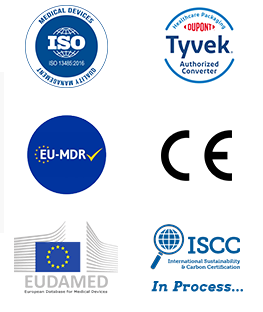In the medical industry, header bags play a crucial role in the sterilization process. These bags are specifically designed to hold and protect medical devices, instruments, and other products during sterilization, ensuring that the items remain sterile after the process is completed.
Here’s how header bags function in the sterilization process:
1. What is a Header Bag?
A header bag is a type of sterilization pouch or packaging bag commonly used in healthcare settings to contain medical instruments or devices that need to be sterilized. These bags are typically made from durable, sterilizable materials like Tyvek®, medical-grade paper, or specialized plastic films that allow for sterilization while maintaining the integrity of the enclosed items.
The term "header" refers to the extra flap of material at the top of the bag that is sealed after loading the items inside. This flap can also contain a sterilization indicator (such as a color change indicator or chemical indicator) to visually confirm that the item inside has been exposed to the correct sterilization conditions.
2. Sterilization Process Using Header Bags:
The sterilization process generally involves heat, gas, or radiation to eliminate any microbial contamination. Header bags must be able to withstand these conditions while ensuring the contents remain sterile. Here’s how header bags work within the sterilization process:
a. Packaging the Items
● Load the Medical Devices or Instruments: First, the medical items are placed inside the header bag. The bag is typically large enough to fit the instruments while leaving enough room to ensure air and sterilizing agents (like steam or gas) can circulate freely around the items.
● Close the Bag: The bag is then sealed at the "header" or top, usually through heat sealing or using an adhesive strip. This ensures the contents are securely enclosed and prevents contaminants from entering during the sterilization process.
b. Sterilization Methods:
The header bag needs to be compatible with various sterilization techniques, such as:
● Steam Sterilization (Autoclaving): For heat-based sterilization, the header bag must withstand high temperatures (usually 121-134°C) and moisture, while still allowing steam to reach the medical devices inside. Materials like Tyvek® or medical-grade paper are often used because they allow steam penetration, while providing a sterile barrier once the cycle is complete.
● Ethylene Oxide (EtO) Gas Sterilization: For gas sterilization, header bags are typically made from materials that can allow the EtO gas to penetrate the bag but also block contaminants after sterilization. The bag must maintain a tight seal and be able to hold up under exposure to the gas.
●Radiation Sterilization: In some cases, medical products are sterilized by exposure to gamma radiation. The header bag must be made from materials that can tolerate radiation without degrading or compromising the sterile barrier.
c. Indicator Systems:、Sterilization Indicators: Header bags often contain chemical indicators or biological indicators to ensure the sterilization process was successful. Chemical indicators change color when the correct sterilization conditions (temperature, time, and pressure) are met. For example, after an autoclave cycle, a color change in the indicator strip would confirm that the proper conditions were achieved.
d. Post-Sterilization:
●Sealing Integrity: After the sterilization cycle, the header bag remains sealed to maintain the sterility of the contents. The materials used to make the bag ensure that it stays intact during handling and transport.
●Storage and Handling: Once sterilized, the bag can be stored and handled with confidence that the contents remain sterile, as long as the integrity of the packaging is maintained (i.e., the bag is not punctured or damaged).
3. Why Header Bags Are Effective for Sterilization:
Header bags are particularly effective because of several reasons:
●Protection Against Contamination: The bag creates a sealed barrier, protecting the contents from contamination during handling, transport, and storage.
●Compatibility with Sterilization Methods: The materials used for header bags are chosen for their ability to handle high temperatures, chemicals, or radiation without compromising the bag's integrity or the sterility of the contents.
●Ease of Use and Visibility: The bags are easy to handle, and the header section allows for clear labeling and indication of the sterilization cycle. Many header bags have transparent windows so the contents can be easily inspected without opening the bag.
●Space Efficiency: Header bags are available in various sizes, allowing for efficient packaging of instruments or devices, and ensuring the sterilizing agents can effectively reach every surface.
4. Benefits in the Medical Industry:
●Safety and Sterility: They ensure that medical devices and instruments stay sterile until they are used, reducing the risk of infection during surgeries or medical procedures.
●Regulatory Compliance: The use of header bags helps manufacturers and healthcare providers comply with regulatory standards for sterilization, such as those outlined by the FDA, ISO, or European Medicines Agency (EMA).
●Waste Reduction: The durability of header bags helps minimize the risk of contamination, reducing the need for re-sterilization and ensuring efficient use of resources.
5. Environmental Considerations:
Many manufacturers are also exploring the use of eco-friendly materials for header bags. Some bags are made from recyclable or biodegradable materials, contributing to sustainability goals in the healthcare sector.
In summary, header bags are a key component of the sterilization process in the medical industry. They provide a reliable way to package, sterilize, and store medical devices and instruments, ensuring that the items remain sterile and safe for use in healthcare settings. Their design allows for compatibility with various sterilization methods, offers protection from contamination, and helps healthcare providers maintain compliance with rigorous industry standards.
DuPont™ and Tyvek® are trademarks or registered trademarks of affiliates of DuPont de Nemours, Inc.

 English
English Français
Français Deutsch
Deutsch Nederlands
Nederlands

 ‘s-Gravenweg 542, 3065SG RotterdamThe Netherlands
‘s-Gravenweg 542, 3065SG RotterdamThe Netherlands
 +31 (0)10 254 28 08
+31 (0)10 254 28 08







